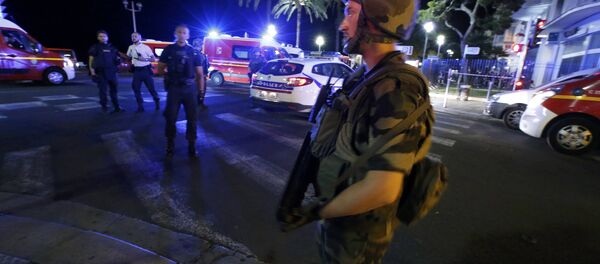On Thursday, a deadly truck attack in Nice killed 84 and wounding dozens more during the Bastille Day celebration.
Just minutes after the details of the attack started emerging, the hashtag #Nice06 was already top trend in France — while #PrayForNice and #NiceAttack started trending worldwide.
Praying for all. No matter the place, we're all feeling the loss 🙏🏻 God give us strength. #TimeToUnite #Nice06 pic.twitter.com/Kvr1e4Z7xM
— Tatiana Judith (@TatianaJudith) July 15, 2016
To all people in #Nice06 stay at home! Don't go out and film what happened, stay safe ❤️
— Paul Ratiu (@pauledratiu) July 14, 2016
R.I.P to everyone that lost their lives in Nice yesterday 💔 #prayfornice pic.twitter.com/LyDLjXpmro
— Jackjonestv (@jackjonestv) July 15, 2016
Stay Informed
The web — and in particular, the so-called Twittersphere — was a key tool French authorities used to warn citizens against leaving their houses while the crisis was still ongoing.
#Nice06 Emergency operation in progress. Keep calm and avoid downtown area. Follow the official accounts to be informed.
— GendarmerieNationale (@Gendarmerie) July 14, 2016
French Embassy Numbers
— SimonNRicketts (@SimonNRicketts) July 14, 2016
British: +33144513100
Irish: +33144176700
US: +33143122222
Australia: +33140593300
Canada: +33144432900 #Nice06
Many ordinary citizens also used the hashtag #PortesOuvertesNice (Open Doors in Nice) giving refuge in their houses to revelers fleeing the Promenade.
To find a refuge: #PortesOuvertesNice
— jtib (@ErMandril) July 15, 2016
To find someone: #RechercheNice
Toll free: +33143175646
Free taxis
Do not share pics of victims
If you need somewhere to crash in #Nice use the hashtag / si vous avez besoin d'un endroit pr trouver refuge #PortesOuvertesNice #solidarité
— Marie Tobia (@MarieTobia1) July 14, 2016
#PortesOuvertesNice TAXIS ARE FREE IN NICE IF YOU NEED ONE!!
— Anima (@Roos1Tia) July 14, 2016
Worried relatives took to Twitter to ask for information regarding loved ones believed to have been present at the scene of the attack.
My sister Leticia was in #Nice06
— A N D A L (@_A_N_D_A_L_) July 14, 2016
I'm really worried, she's not answering her phone, Please help!!!! pic.twitter.com/41C4jZIgeQ
'Show Some Respect'
At the same time, many Twitter users were upset with graphic images and videos of the victims appearing on their newsfeed.
could you please stop retweeting the video showing people dying/dead on the street? do show some respect, thank you #Nice06
— rochana (@itsrochana) July 14, 2016
Please DO NOT share #NiceAttack aftermath video! Awful images! Let's not share the terror #BastilleDay
— Line Hassall Thomsen (@HassallThomsen) July 14, 2016
If you filmed someone dying instead of helping them, what would you say to their family? How do you justify your existence? #Nice06
— JDA (@the__littleman) July 14, 2016
Others defended spreading images on the ground of freedom of press and people's right to be informed. It is also debatable that someone who is not a trained professional could provide proper medical assistance to severely injured victims.
The French Gendarmerie, anyway, took a stance against sharing videos of the attack's aftermath, going as far as setting up a service to flag up and remove "shocking videos and pictures."
Rumors and Hoaxes
Another inevitable side effect of the social media post-attack hysteria can be reckless or just careless propagation of unfounded rumors and hoaxes.
At some point after the Nice attack, an image of the Eiffel Tower shrouded in cloud of smoke started to circulate, with the implication another attack had taken place in Paris.
#BREAKING Fire near Eiffel Tower following the attack in Nice pic.twitter.com/MXO8SaWT7i
— Ragıp Soylu (@ragipsoylu) July 14, 2016
In fact the image, while genuine, was just portraying a minor incident involving fireworks. Rumors about a hostage situation somewhere in Nice started to spread too, but they were then revealed to be unfounded.
OMG! Nice now reporting 60 dead in #BastilleDay terror attack, others taken hostage! #ReligionOfPeace
— Lori Hendry (@Lrihendry) July 14, 2016
Unconfirmed eye witness says hostage crisis in Meridien and Negresco hotels in #Nice https://t.co/se22kLO77J
— Emma-Kate Symons (@eksymons) July 14, 2016
The Gendarmerie asked users not to "propagate rumors."
#Nice06 Don't propagate rumors and don't broadcast shocking photos or videos
— GendarmerieNationale (@Gendarmerie) July 14, 2016
Trolls
Still, at least one of the Twitter-dwellers appear not to have paid heed to the plea. A user going by the handle @desquciadown tweeted asking information about his missing brother Robert, who he said to be in Nice.
I'm looking for my brother. His name is Robert and I can't find him
— Elliot (@desquiciadown) July 14, 2016
We were in Nice #Nice06 #nizza@pzf
HELP! pic.twitter.com/R1NokEEG5w
The man portrayed in 'Robert's' picture is actually a Mexican citizen whose picture has regularly been tweeted in connection with terror attacks carried out over the last few months — from Paris to Orlando.
And while terrorism threatens the real world, for social media — the the real struggle is between good will and lie mongering.





